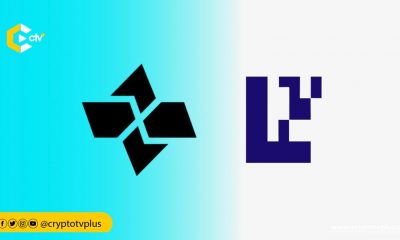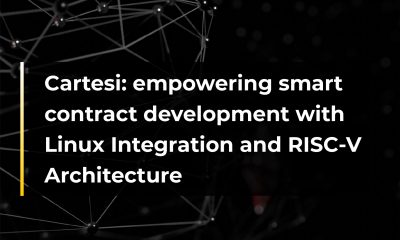FEATURED
The Concept of Cryptocurrency Mining and How Cartesi Best Fits In

About Cryptocurrency Mining
Cryptocurrencies are digital assets which are designed for use as medium of exchange on a public financial transaction database i.e. blockchain. These digital assets do not exist in physical form and are typically not issued by a central authority. Also, they are based on decentralized control as opposed to other financial transaction media.
Cryptocurrency mining is a process by which new transactions are validated, recorded and added to the digital ledger. It is the distributed process of verifying digital currency transactions and adding them to the blockchain in pursuit of transaction fees and additional digital currency. Cryptocurrency mining is necessary to maintain the ledger of transactions upon which the cryptocurrency is based.
Each time a cryptocurrency transaction is made, a miner is responsible for verifying the authenticity of the transaction data and updating the blockchain with the transaction. This process entails the solving of complicated mathematical puzzles with cryptographic hash functions which are associated with a block containing the transaction data. The first miner to solve the puzzles and validate the transaction is rewarded with certain amounts of the cryptocurrency. This ensures that miners remain incentivized to validate new transactions that are added to the ledger.
There are different types of cryptocurrency mining; one mining is PoW systems, another type of mining is referred to as PoS (like CTSI Reserve Mining) which does not run on PoW, but is a way of acquiring tokens in return for work done, another form of mining is Liquidity mining, and so on. The first two are discussed in the next section.
Consensus Protocols in Cryptocurrency Mining
Consensus protocols are algorithms designed to allow the validation of legal transactions to occur within a blockchain network. These algorithms keep the network alive, enabling it to reach consensus, validate transactions and add trust to the peer-to-peer network.
There are two common types of consensus protocols. These are:
• Proof of Work (PoW) protocol, and
• Proof of Stake (PoS) protocol.
- The Proof-of-Work protocol is a transaction validation protocol in which energy is transformed into value to confirm transactions. It is the original consensus algorithm for validating block transactions. In the period of the work, miners essentially work competitively to solve complex mathematical puzzles in order to validate transactions in the network and prevent double spend attacks.
Although the Proof-of-Work system is the original consensus algorithm for validating transactions, it faces numerous challenges which prevent its wide use. These challenges include large computational power requirements, the susceptibility to 51% attacks, the possibility of forking and the slow nature of the system. To tackle these challenges, the Proof-of-Stake system was designed.
- The Proof-of-Stake (PoS) system is a transaction validation protocol that allows users to validate transactions based on the number of coins they possess. The system achieves consensus by asking users to stake their funds into the platform in exchange for the rights to perform tasks on the network. The stakes are locked as collateral and can be lost in case of malicious behaviour.
The Proof-of-Stake system solves the large computational power problem by attributing validating power to the proportion of coins possessed held by the validator. Also, the system allows validators to receive a portion of the fees included in the block in proportion to what they have previously staked. This prevents the likelihood of attack by ensuring that attackers who try to validate bad blocks lose their stakes and are barred from executing subsequent validations, leading us to the CTSI Reserve Mining.
Recently, Cartesi (CTSI), which is a platform that takes smart contracts on Ethereum to the next level by helping developers build sophisticated decentralized applications with the use of Linux Infrastructure, announced the release of its mainnet Proof-of-Stake system to bootstrap it’s data availability sidechain, Noether. Following its mainnet launch, the project commenced CTSI reserve mining. CTSI reserve mining entails the staking of the Cartesi (CTSI) token by validators to receive staking rewards, this bootstraps the future network of Noether.
With the commencement of this reserve mining, users can stake their CTSI tokens to receive mining rewards. To stake CTSI tokens and receive mining rewards successfully, stakers can run their own Cartesi node or use custodial staking services that Cartesi partnered with such as MyCointainer, Coinone, and more coming soon. The essence of these custodial services is to make life easier for interested and potential participants who do not know how to run a node themselves, so such individuals can use any of the authorized custodial staking partners of Cartesi. Primarily, what they do is to hold your CTSI and stake via their own node on your behalf. All rewards will then be distributed to your account periodically after their fees are deducted. You can get to learn more about them.
As the network is bootstrapped, Cartesi will be releasing Noether. In a later version of the Cartesi PoS system in 2022, node operators will also be able to stake CTSI by buying staking rights. These staking rights keep CTSI locked until the end of the staking cycle after which it pays the owner the locked principal with the addition of a reward in CTSI.
The staking rights which are utilized by node operators to participate in staking are acquired through periodic Dutch auctions. These rights give the owner the chance to execute rewarded mining tasks until their expiration date. Without the rights, operators cannot be selected in the lottery that chooses the node which will generate the next block.
The Cartesi staking rights also grant their owners the chances to benefit from three different sources of incentives provided that the owner remains active within the network. These sources are the staking right’s unit CTSI value paid at the end of the cycle, the mine reserve rewards and the fees paid by network users when they use the Cartesi side chain. However, the auction system and staking rights are currently not available and staking is being done directly with CTSI token deposits at the moment.
According to the publicized token distribution report, 25% of the total CTSI supply has been set aside for the mine reserve. These tokens will help bootstrap the staking participation rate until the fees paid by the network users become large enough to sustain an appropriate staking rate. At the end of each staking phase, the allotted staking rewards will be split among the stakers based on the proportion of tokens they stake.
The CTSI Reserve Mining in Comparison to Other Liquidity Mining Initiatives:
- The major challenge faced by most liquidity mining initiatives is centered on how to measure the opportunity costs of users and how to choose the appropriate minting amount to achieve a target participation rate, while avoiding exceedingly high inflation rates. This challenge has limited the scalability of most initiatives. Cartesi tackles this challenge by providing a staking system based on a novel mechanism called staking rights.
- Also, unlike other mining initiatives that compromises either of security, decentralization or scalability, the Cartesi PoS system governs the network efficiently and balances the tradeoffs between these desirable properties.
- Furthermore, the staking system of Cartesi overcomes major issues encountered by most Proof of Stake systems. This is achieved by the system as it allows stakers to express and apply different risk preferences. Similarly, the system is balanced to minimize inflation while maintaining the security of the network and no assumptions are made about users’ risk preferences.
Conclusion
The Cartesi reserve mining project is designed to stimulate high participation rates in the Cartesi mainnet. With the commencement of the reserve mining, cryptocurrency enthusiasts, especially in African countries where the adoption of cryptocurrencies for digital transactions is on the rise, can take advantage of this opportunity by the Cartesi project to stake CTSI tokens and earn mining rewards.
For more information about the Cartesi project, you can check the following links:
Website: https://cartesi.io
Whitepaper: https://cartesi.io/cartesi_whitepaper.pdf
Twitter: https://twitter.com/cartesiproject
Explorer: https://explorer.cartesi.io
Blog: https://medium.com/cartesi
Telegram Community: https://t.me/CartesiProject
Telegram Announcements: https://t.me/cartesiannouncements
Discord (Development Community): https://discordapp.com/invite/Pt2NrnS
GitHub: https://github.com/cartesi
Reddit: https://www.reddit.com/r/cartesi/
Article Written by Helen IMAH – Lead at Cartesi Nigeria

















1 Comment